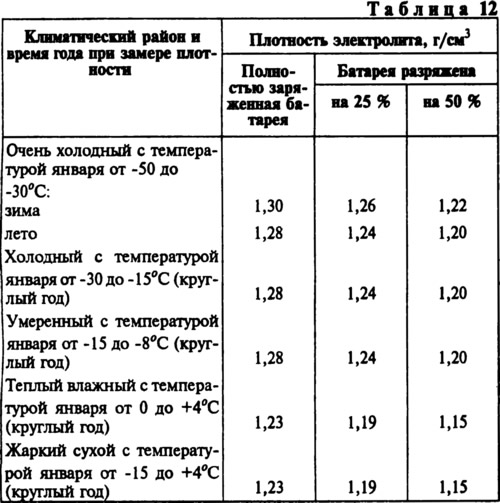Checking the electrolyte level
The electrolyte level should be 5-10 mm above the upper edge of the separators and not rise above the lower edge of the filler neck. During operation of the battery, the electrolyte level gradually decreases, as the water that is part of it evaporates. To restore the electrolyte level, add distilled water.
If it is determined that the cause of the low level is sloshing, then it is necessary to add electrolyte of the same density as that remaining in the battery cell. If the level is above normal, then the electrolyte must be taken with a rubber bulb.
Checking the degree of discharge of the battery
To determine the degree of discharge, measure the density of the electrolyte with a car dynsimeter and compare it with the data in Table. 12. If the battery is discharged by more than 25% in winter and 50% in summer, then it should be removed from the vehicle and recharged.

The density of the electrolyte depends on the temperature. With a change in the latter for every 15°C, the density changes by approximately 0.01 g / cm3. Therefore, if the electrolyte temperature differs from 25°C, then the temperature correction should be added or subtracted from the densimeter readings:

To avoid erroneous results, do not measure the electrolyte density in the following cases:
- if its level does not correspond to the norm;
- when the electrolyte is too hot or too cold. The optimum temperature of the electrolyte when measuring density is 15–25°C;
- immediately after topping up with distilled water. Wait until the electrolyte is mixed. If the battery is low, this may even take several hours;
- after a few starts. It is necessary to wait until a uniform electrolyte density is established in the battery cells;
- at «boiling» electrolyte. You should wait until the bubbles in the electrolyte collected in the densimeter pipette rise to the surface.
If, when measuring the density of the electrolyte, it is found that it is excessively high (1.3 g/cm3 and higher), then it is necessary to take away part of the electrolyte from the cell and add distilled water instead, wait until the electrolyte is mixed, and measure the density again.
If the density of the electrolyte is low, then after removing it from the cell, add electrolyte with a density of 1.40 g/cm3.
When measuring density, be careful not to drop drops of electrolyte containing sulfuric acid on the surface of the battery, body and other parts from the pipette, which causes corrosion, current leakage, etc.
Battery charge
Carefully clean the battery removed from the car, especially its upper part, check the electrolyte level and bring it to normal. The battery is charged with a current of 5.5 A with the plugs turned out. The charge stops when copious gas evolution begins in all battery compartments, and the voltage and density of the electrolyte during the last three measurements (held after 1 hour) will remain constant. The density of the electrolyte of a charged battery at 25°C must correspond to the data in Table. 12.
When charging the battery, periodically check the temperature of the electrolyte and do not allow it to rise above 40°C. If the temperature reaches 40°C, then reduce the charging current by half or interrupt the charge and cool the battery down to 27°C.
If at the end of the charge the density of the electrolyte (determined taking into account the temperature correction) differs from that indicated in the table. 12, then correct it. Then continue charging the battery for another 30 minutes to mix the electrolyte.
Disconnect the battery and after 30 minutes measure its level in all elements. If the electrolyte level differs from the norm, then bring it to the recommended value, as indicated earlier.
